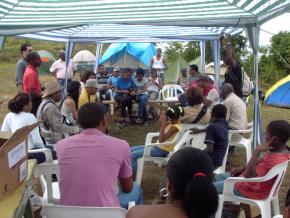Dominicans defend biodiversity
looks at the rise of an important new environmental struggle in the Dominican Republic.
ENVIRONMENTAL ACTIVISTS around the Dominican Republic are mobilizing to stop the construction of a cement factory in the Los Haitises national park. The factory would displace 500 peasant families and degrade one of the most important ecosystems in the country and the Caribbean region.
Los Haitises is located in the municipality of Gonzalo, one of the poorest towns in the country, and is a repository of vast water reservoirs that benefit more than 1 million people.
The move to allow construction of a highly toxic factory amounts to a new government privatization of public lands. It's also part of a recent right-wing assault on civil liberties that led to the outlawing of abortion in April. That success has given the government more confidence to bypass the country's environmental laws.
But resistance is building. On May 16, hundreds of activists set up an encampment in Los Haitises to protest a recent government concession granted to the Consorcio Minero Dominicano (Dominican Mining Consortium) to extract limestone from sedimentary rocks to manufacture cement. In the recent weeks, the local population led huge mobilizations against the mining company to defend the biodiversity that sustains the local economy and their lives.
As soon as news spread about the proposed cement factory, student activists organized a campaign to revoke the government concession. In addition, the left and some labor unions expressed solidarity with the struggle and joined the encampment.
Meanwhile, the nominally left-wing Dominican Revolutionary Party (PRD), the second-largest opposition party, is calling the government to revoke the concession.
The government concession was issued by Jaime David Fernández Mirabal, the environment minister. He is under criticism for going against the advice of his own technicians in the Environment and Natural Resources Department, who issued a report warning of the environmental destruction the construction of a cement factory in Los Haitises could unleash.
Mirabal was vice president from 1996 to 2000 during the first administration of current President Leonel Fernández. That government also privatized national landholdings, including the sale of public beaches in order to attract foreign investment in the tourist sector.

Today, however, many commentators say that Mirabal is out of touch with public opinion, since he refuses to back down in spite of widespread opposition to the cement factory. Geologists and environmentalists have joined the opposition to the factory, pointing out that Mirabal's decision violates more than 20 environmental laws. (Fernández, for his part, is on an official European visit to avoid criticism).
Moreover, a second report issued jointly by the Academy of Science and the Environmental Commission of the State University (UASD) called for the immediate revocation of the government concession and relocation of peasant's communities who have been displaced throughout the years.
Since the 1980s, thousands of Haitian and Dominican peasants have been forcefully removed from Los Haitises by the military. Though the Dominican government promised to pay compensation for their lands and crops, compensation never arrived in most cases. Prior to carrying out any evictions, the government criminalizes peasants with the aid of the mainstream media by accusing them of cutting down trees and destroying the biodiversity of the park.
But the sole purpose of evicting peasants to declare Los Haitises a protected area was to exert more private control over the forest and exploit its natural resources. The real criminals here aren't the local peasants, but politicians and powerful economic interests.
They may not get their way, however. Student activists are bringing together a new generation of environmentalists and left-wingers for the first time to build a united front of sorts. This will lay the ground for a stronger environmentalist movement in the future.
It's important that we show solidarity with the people of Los Haitises to win the fight against privatization of national resources and displacement of people from their homes before it is too late.


